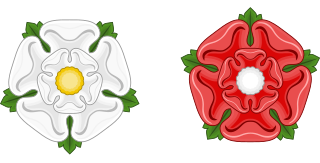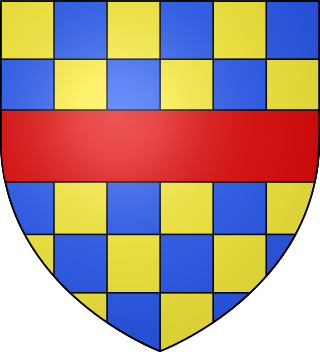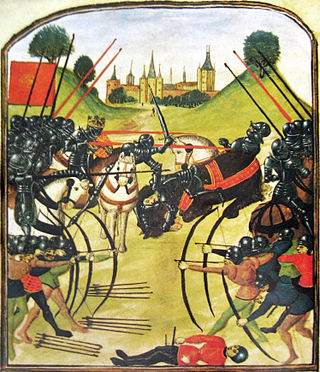Andrew Trollope | |
|---|---|
| Died | 29 March 1461 Near Towton, Yorkshire, England |
| Battles/wars | |

Sir Andrew Trollope (died 29 March 1461) was an English professional soldier who fought in the Hundred Years' War and the Wars of the Roses.
Andrew Trollope | |
|---|---|
| Died | 29 March 1461 Near Towton, Yorkshire, England |
| Battles/wars | |

Sir Andrew Trollope (died 29 March 1461) was an English professional soldier who fought in the Hundred Years' War and the Wars of the Roses.
Born into a family of Durham dyers, Trollope began his long military career in France in the 1420s as a man-at-arms, serving first on Tombelaine under Thomas Burgh and then with the garrisons at Fresnay-le-Vicomte and Caen under John Fastolf in the Duke of Somerset's raid into Picardy in February 1440. Trollope served in Matthew Gough's company. By 1442, he was lieutenant at Fresnay under Richard Woodville and held the same position under Osbert Mundeford when he surrendered the castle to the French in 1450. [1]
Sometime before 1455, he married Elizabeth, sister of Osbert Mundeford (a protégé of the Beaufort family, who became treasurer-general of the duchy of Normandy in September 1448), and this connection allowed Trollope to prosper in his military career. By 1455, Trollope was made Master Porter of Calais, [1] a capacity in which he continued to serve until 1459. It was in this office that he prevented pirates and French ships alike from sailing, but also seized and stole from "the ships of allies and subjects alike" to such an extent that he has been called a "freebooter". [2]
Shortly before the confrontation at Ludford Bridge, Trollope sailed for England with Richard Neville, 16th Earl of Warwick known as (the "Kingmaker"). [1] At the Rout of Ludford Bridge Trollope commanded part of the Yorkist army of Richard of York, 3rd Duke of York, but he defected to King Henry VI's side bringing with him 600 men and "valuable intelligence" regarding York's army. [1] [3]
Trollope returned to France with Henry Beaufort, 3rd Duke of Somerset to aid in the capture of Calais. Somerset failed to achieve this, but Trollope did persuade the garrison of Guînes to come over to the Lancastrians, and was appointed bailiff of Guînes on 24 March and expected to defend it. However, Somerset's defeat at the Battle of Newenham Bridge (Pont de Nieulay) on 23 April and the failure of Mundeford to supply a relief force (it was intercepted at the port of Sandwich in June) forced Trollope to surrender Guînes to the Yorkists shortly afterwards, and he then returned to England. [1] [4]
Trollope proved to be an invaluable strategist to Margaret of Anjou. [1] He took part in the ambush at the Battle of Worksop on York's march north in December 1460 [5] and then supposedly devised the Lancastrian plan at the Battle of Wakefield, where York and Richard Neville, 5th Earl of Salisbury were killed. Andrew Trollope also fought at the Second Battle of St Albans (where he stepped on a caltrop) and was knighted by Prince Edward. [1]
His importance to the Lancastrian cause can be seen by the fact that, in March 1461, the recently proclaimed King Edward IV offered a £100 reward to anyone who killed "certain named enemies of the House of York", which included Trollope. [6]
At the Battle of Towton (29 March 1461) Trollope shared the command of the Lancastrian vanguard with Henry Percy, 3rd Earl of Northumberland, against the Yorkist army of Edward IV. [1] Considered the "opposite number" of his contemporary William Neville, 1st Earl of Kent, Trollope's death in the battle was "a damaging blow" for the future of the Lancastrian cause. [7] He was posthumously attainted, and his son David Trollope was also killed at Towton.[ citation needed ]
Trollope and his wife, Elizabeth Mundeford, had a daughter who became Margaret Calle when she married Richard Calle of Bacton, bailiff of the Pastons. [1] Richard Calle had previously been married to Margery Paston, which had caused a famous rift in the Paston family. The Bishop was called but he could not annul the marriage so the couple were banished. The daughter was not forgiven but Richard was in time re-employed. [8]

Edward IV was King of England from 4 March 1461 to 3 October 1470, then again from 11 April 1471 until his death in 1483. He was a central figure in the Wars of the Roses, a series of civil wars in England fought between the Yorkist and Lancastrian factions between 1455 and 1487.

The Battle of Wakefield took place in Sandal Magna near Wakefield in northern England, on 30 December 1460. It was a major battle of the Wars of the Roses. The opposing forces were an army led by nobles loyal to the captive King Henry VI of the House of Lancaster and his Queen Margaret of Anjou on one side, and the army of Richard, Duke of York, the rival claimant to the throne, on the other.

The Battle of Towton took place on 29 March 1461 during the Wars of the Roses, near Towton in North Yorkshire, and "has the dubious distinction of being probably the largest and bloodiest battle on English soil". Fought for ten hours between an estimated 50,000 soldiers in a snowstorm on Palm Sunday, the Yorkist army achieved a decisive victory over their Lancastrian opponents. As a result, Edward IV deposed the Lancastrian Henry VI and secured the English throne.
John Neville, 1st Marquess of Montagu was a major magnate of fifteenth-century England. He was a younger son of Richard Neville, 5th Earl of Salisbury, and the younger brother of Richard Neville, Earl of Warwick, the "Kingmaker".

Henry Beaufort, 3rd Duke of Somerset was an important Lancastrian military commander during the English Wars of the Roses. He is sometimes numbered the 2nd Duke of Somerset, because the title was re-created for his father after his uncle died. He also held the subsidiary titles of 5th Earl of Somerset, 2nd Marquess of Dorset and 2nd Earl of Dorset.

Henry Holland, 3rd Duke of Exeter, 3rd Earl of Huntington was a Lancastrian leader during the English Wars of the Roses. He was the only son of John Holland, 2nd Duke of Exeter, and his first wife, Anne Stafford. His maternal grandparents were Edmund Stafford, 5th Earl of Stafford, and Anne of Gloucester.

Henry Percy, 3rd Earl of Northumberland, was an English magnate.

The Battle of Northampton was fought on 10 July 1460 near the River Nene, Northamptonshire. It was a major battle of the Wars of the Roses. The opposing forces were an army led by nobles loyal to King Henry VI of the House of Lancaster, his Queen Margaret of Anjou and their six-year-old son Edward, Prince of Wales, on one side, and the army of Edward, Earl of March, and Warwick the Kingmaker on the other. The battle was the first in which artillery was used in England.

The Rout of Ludford Bridge was a largely bloodless confrontation fought in the early years of the Wars of the Roses. It took place on 12 October 1459, and resulted in a setback for the Yorkists. Although this seemed to be a triumph for the rival Lancastrians at the time, they had thrown away their advantage within six months.

John Mowbray, 3rd Duke of Norfolk,, Earl Marshal was a fifteenth-century English magnate who, despite having a relatively short political career, played a significant role in the early years of the Wars of the Roses. Mowbray was born in 1415, the only son and heir of John de Mowbray, 2nd Duke of Norfolk, and Katherine Neville. He inherited his titles upon his father's death in 1432. As a minor he became a ward of King Henry VI and was placed under the protection of Humphrey, Duke of Gloucester, alongside whom Mowbray would later campaign in France. He seems to have had an unruly and rebellious youth. Although the details of his misconduct are unknown, they were severe enough for the King to place strictures upon him and separate him from his followers. Mowbray's early career was spent in the military, where he held the wartime office of Earl Marshal. Later he led the defence of England's possessions in Normandy during the Hundred Years' War. He fought in Calais in 1436, and during 1437–38 served as Warden of the Eastern March on the Anglo-Scottish border, before returning to Calais.

John Clifford, 9th Baron Clifford, 9th Lord of Skipton was a Lancastrian military leader during the Wars of the Roses in England. The Clifford family was one of the most prominent families among the northern English nobility of the fifteenth century, and by the marriages of his sisters, John Clifford had links to some very important families of the time, including the earls of Devon. He was orphaned at twenty years of age when his father was slain by partisans of the House of York at the first battle of the Wars of the Roses, the Battle of St Albans in 1455. It was probably as a result of his father's death there that Clifford became one of the strongest supporters of Margaret of Anjou, wife of King Henry VI, who ended up as effective leader of the Lancastrian faction.
John Neville, Baron Neville was an English nobleman who fought for the House of Lancaster during the Wars of the Roses. He belonged to a senior but impoverished branch of the Neville family of northern England, which had earlier been disinherited in favour of a younger branch headed by John's half–uncle, Richard, Earl of Salisbury. John Neville and his brothers spent several years feuding with Salisbury over the contested inheritance and, when the dynastic wars broke out, John sided with the Lancastrians whilst the junior Nevilles sided with the House of York.

James Butler, 5th Earl of Ormond, Earl of Wiltshire was an Anglo-Irish nobleman and soldier. Butler was a staunch Lancastrian and supporter of Queen consort Margaret of Anjou during the Wars of the Roses. He was beheaded by the victorious Yorkists following the Battle of Towton.
Events from the 1460s in England.

Thomas Courtenay, 6th/14th Earl of Devon, was the eldest son of Thomas de Courtenay, 5th/13th Earl of Devon, by his wife Margaret Beaufort, the daughter of John Beaufort, 1st Earl of Somerset, and Margaret Holland, daughter of Thomas Holland, 2nd Earl of Kent. Through his mother, he was a great-great-grandson of King Edward III. The ordinal number given to the early Courtenay Earls of Devon depends on whether the earldom is deemed a new creation by the letters patent granted 22 February 1334/5 or whether it is deemed a restitution of the old dignity of the de Redvers family. Authorities differ in their opinions, and thus alternative ordinal numbers exist, given here.

The Wars of the Roses (1455–1487), known at the time and for more than a century after as the Civil Wars, was a series of civil wars fought over control of the English throne in the mid-to-late fifteenth century. These wars were fought between supporters of two rival cadet branches of the royal House of Plantagenet: Lancaster and York. The wars extinguished the last male line of the House of Lancaster in 1471, leading to the Tudor family inheriting the Lancastrian claim to the throne. Following the war and the extinction of the last male line of the House of York in 1485, a politically arranged marriage united the Houses of Lancaster and York, creating a new royal dynasty which inherited the Yorkist claim as well, thereby resolving the conflict.

The First Battle of St Albans took place on 22 May, 1455, at St Albans, 22 miles (35 km) north of London, and traditionally marks the beginning of the Wars of the Roses in England. Richard, Duke of York, and his allies, the Neville Earls of Salisbury and Warwick, defeated a royal army commanded by Edmund Beaufort, Duke of Somerset. Unusually, the battle was contested in the town of St Albans itself, with the bulk of the fighting taking place in the streets and a tavern being used as a redoubt. Somerset was killed in the battle, and King Henry VI captured, clearing the way for a subsequent parliament to appoint Richard of York Lord Protector.

The Second Battle of St Albans was fought on 17 February 1461 during the Wars of the Roses in St Albans, Hertfordshire, England.

John Beaumont, 1st Viscount Beaumont, was an English nobleman and magnate from Folkingham, Lincolnshire. He was a councillor to King Henry VI and was rewarded for his services, becoming a leading member of the East Anglian nobility. Beaumont held numerous offices for the crown, and was promoted up the peerage to become the first man with the rank of viscount. He also amassed immense personal wealth, acquired through inheritance, marriage, and royal patronage.

The siege of the Tower of London was an episode of the Wars of the Roses, in which adherents of the rival Plantagenet houses of Lancaster and York were pitted against each other. In June 1460, several Yorkist nobles, who had unsuccessfully rebelled against King Henry VI the year before and had fled to Calais, invaded the south east of England at Sandwich. They enjoyed widespread support through popular discontent with the ruling court among the populace of Kent and the merchants of London, and were greeted by enthusiastic crowds when they entered London on 2 July.
{{cite book}}: CS1 maint: location missing publisher (link){{cite book}}: CS1 maint: location missing publisher (link)